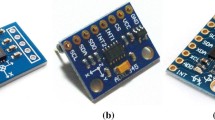Abstract
Being man–machine interaction, the use of surface electromyogram (sEMG) is increasing day by day. Generally, sEMG is a complex signal and is influenced by several external factors/artifacts. As removing these artifacts is not easy, feature extraction to obtain useful information hidden inside the signal becomes a different process. This paper presents methods of analyzing sEMG signals using discrete wavelet transform for extracting accurate patterns of the sEMG signals. The results obtained suggest having a good compromise between the percentage root mean square differences, root mean square difference value for the denoising and quality of reconstruction of the sEMG signal. Further a one way separated factorial analysis was performed to find out the effectiveness of analyzed sEMG signal for discrimination among different classes of groups Various possible types of wavelets with high level parameters were tested for denoising and results show that the best mother wavelets for tolerance of noise are fifth order of symmlets and bior6.8 whereas for reconstruction, wavelet functions bior5.5 and sym3 were the best.







Similar content being viewed by others
References
Kilby J, Hosseini Gholam H (2006) Extracting effective features of SEMG using continuous wavelet transform. In: Proceedings of the 28th IEEE EMBS annual international conference, pp 1704–1707. New York City, USA
Katherine WA, Hiroshima S, Dinesh KK, Sridhar AP (2010) A sEMG model with experimentally based simulation parameters. In: Proceedings of the 32nd annual international conference of the IEEE EMBS Buenos, pp 4258-4261. Buenos Aires, Argentina
Englehart K, Hudgin B, Parker P (2001) A wavelet-based continuous classification scheme for multifunction myoelectric control. IEEE Trans Biomed Eng 48:302–311
Phinyomark A, Phukpattaranont P, Limsakul C (2012) The usefulness of mean and median frequencies in electromyography analysis-chapter 8. In: Computational intelligence in electromyography analysis: a perspective on current applications and future challenges, pp 195–220. InTech, ISBN:978-953-51- 0805-4
Ching CP, So CH, Wu QS (1999) On wavelet denoising and its applications to time delay estimation. IEEE Trans Signal Process 47:2879–2882
David DL (1995) De-noising by soft-thresholding. IEEE Trans Inf Theory 41:613–627
Veer K, Agarwal R (2015) Wavelet and short-time Fourier transform comparison-based analysis of myoelectric signals. J Appl Stat 42:1591–1601
Rodrigo OL, Ricardo MN, Roberto PR, Cabral M, Cristina N, José PC, Alberto C (2010) Evaluation of adaptive/nonadaptive filtering and wavelet transform techniques for noise reduction in EMG mobile acquisition equipment. IEEE Trans Neural Syst Rehabil Eng 11:60–69
Silvestro M (2010) Control of hand prostheses using peripheral information. IEEE Rev BME 3:48–68
Reaz MBI, Hussain MS, Mohd-Yasin F (2006) Techniques of EMG signal analysis: detection processing, classification and applications. IEEE Trans Biomed Eng 10:11–35
Veer K (2015) A technique for classification and decomposition of muscle signal for control of myoelectric prostheses based on wavelet statistical classifier. Measurement 60:283–291
Phinyomark A, Phukpattaranont P, Limsakul C (2011) Wavelet-based denoising algorithm for robust EMG pattern recognition. Fluct Noise Lett 10:157–167
Ntsama PE, Ele P, Kabiena BI (2013) Compression approach of EMG signal using 2D discrete wavelet and cosine transforms. Am J Signal Process 3:10–16
Acknowledgments
The author is grateful to Dr. Amod Kumar, Chief Scientist, CSIO-Chandigarh for helping in writing this manuscript.
Author information
Authors and Affiliations
Corresponding author
Rights and permissions
About this article
Cite this article
Veer, K. Wavelet Transform to Recognize Muscular: Force Relationship Using sEMG Signals. Proc. Natl. Acad. Sci., India, Sect. A Phys. Sci. 86, 103–112 (2016). https://doi.org/10.1007/s40010-015-0245-x
Received:
Accepted:
Published:
Issue Date:
DOI: https://doi.org/10.1007/s40010-015-0245-x




